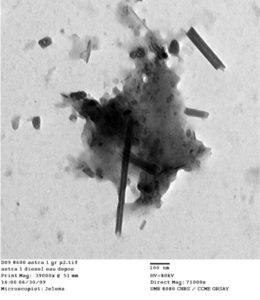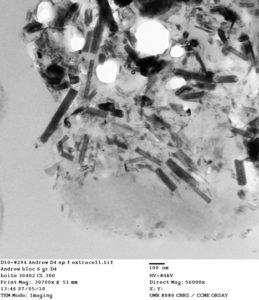Scary study results showing what may scientists have long feared - that carbon nanotubes are being released into the environment and getting into our bodies with unknown health effects. The researchers point out that fine particulate matter (PMs) from air pollution penetrate lower airways and are associated with adverse health effects even with low concentrations and that carbon nanotubes are part of this fine particulate matter. Here they discussed how catalytic converters may convert carbon monoxide into carbon nanotubes during the process of converting carbon monoxide into safer emissions. The problem with carbon nanotubes is that they are so small - so small that we inhale them, but can't cough them out. Carbon nanotubes can be envisioned as one-atom thick sheets of carbon atoms that have been rolled into tubes with diameters as small as 1 nm and lengths up to several centimeters. And scientists are concerned that they may have inflammatory effects on the lungs (similar to what asbestos does). Of course the long-term studies have not yet been done....Because once again, technological advances have outpaced any safety sudies. The researchers studied the lung cells of children with asthma, but it is unclear whether the carbon nanotubes had any effect on or caused their asthma.
Two additional areas of serious concern regarding carbon nanotubes: (1) many tires now contain carbon nanotubes, and with abrasion (wear and tear) the nanotubes are released into the air (air pollution), and (2) the tire crumb fill used in synthetic turf fields. People, including athletes and developing children, are playing on these fields and whatever is in the tires (toxic chemicals, lead, etc. and carbon nanotubes) is being released into the air, and inhaled and ingested by those playing and exercising on the synthetic turf. From Futurity:
Nanotubes Found in Lungs of French Kids
Cells taken from the airways of Parisian children with asthma contained man-made carbon nanotubes—just like the kind found in the exhaust pipes of vehicles in Paris. The researchers report in the journal EBioMedicine that these samples align with what has been found elsewhere in US cities, in spider webs in India, and in ice cores. The research in no way ascribes the children’s conditions to the nanotubes, says Rice University chemist Lon Wilson, a corresponding author of a new paper describing the work. But the nanotubes’ apparent ubiquity should be the focus of further investigation, he adds.
“We know that carbon nanoparticles are found in nature,” Wilson says, noting that round fullerene molecules like those discovered at Rice are commonly produced by volcanoes, forest fires, and other combustion of carbon materials. “All you need is a little catalysis to make carbon nanotubes instead of fullerenes.”
 Carbon nanotubes (the long rods) and nanoparticles (the black clumps) appear in vehicle exhaust from tailpipes of cars in Paris.
Carbon nanotubes (the long rods) and nanoparticles (the black clumps) appear in vehicle exhaust from tailpipes of cars in Paris.

Carbon inside a lung cell vacuole takes the form of nanotubes (rods) and nanoparticles (black clumps). Credit: Both photos Fathi Moussa, Paris-Saclay Univ.
A car’s catalytic converter, which turns toxic carbon monoxide into safer emissions, bears at least a passing resemblance to the high-pressure carbon monoxide, or HiPco, process to make carbon nanotubes, he says. “So it is not a big surprise, when you think about it,” Wilson adds.
The team—led by Wilson, Fathi Moussa of Paris-Saclay University, and lead author Jelena Kolosnjaj-Tabi, a graduate student at Paris-Saclay—analyzed particulate matter found in the alveolar macrophage cells (also known as dust cells) that help stop foreign materials like particles and bacteria from entering the lungs.
The cells were taken from 69 randomly selected asthma patients aged 2 to 17 who underwent routine fiber-optic bronchoscopies as part of their treatment. For ethical reasons, no cells from healthy patients were analyzed, but because nanotubes were found in all of the samples, the study led the researchers to conclude that carbon nanotubes are likely to be found in everybody.
The study notes but does not make definitive conclusions about the controversial proposition that carbon nanotube fibers may act like asbestos, a proven carcinogen. But the authors reminded that “long carbon nanotubes and large aggregates of short ones can induce a granulomatous (inflammation) reaction.”
The study partially answers the question of what makes up the black material inside alveolar macrophages, the original focus of the study. The researchers found single-walled and multiwalled carbon nanotubes and amorphous carbon among the cells, as well as in samples swabbed from the tailpipes of cars in Paris and dust from various buildings in and around the city. “The concentrations of nanotubes are so low in these samples that it’s hard to believe they would cause asthma, but you never know,” Wilson says. “What surprised me the most was that carbon nanotubes were the major component of the carbonaceous pollution we found in the samples.”
The nanotube aggregates in the cells ranged in size from 10 to 60 nanometers in diameter and up to several hundred nanometers in length, small enough that optical microscopes would not have been able to identify them in samples from former patients. The new study used more sophisticated tools, including high-resolution transmission electron microscopy, X-ray spectroscopy, Raman spectroscopy, and near-infrared fluorescence microscopy to definitively identify them in the cells and in the environmental samples.
“We collected samples from the exhaust pipes of cars in Paris as well as from busy and non-busy intersections there and found the same type of structures as in the human samples,” Wilson says. “It’s kind of ironic. In our laboratory, working with carbon nanotubes, we wear facemasks to prevent exactly what we’re seeing in these samples, yet everyone walking around out there in the world probably has at least a small concentration of carbon nanotubes in their lungs,” he says. The researchers also suggest that the large surface areas of nanotubes and their ability to adhere to substances may make them effective carriers for other pollutants.
